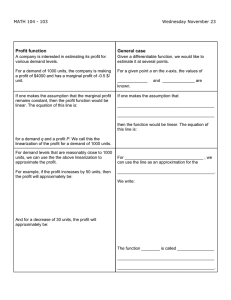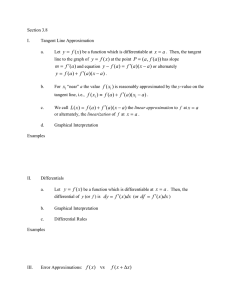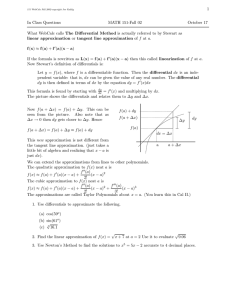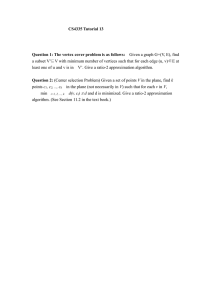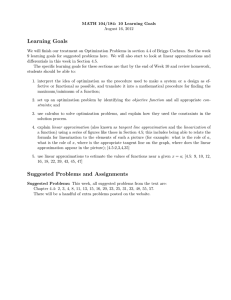Linear Appr oximat ion Instructor’s Guide
advertisement
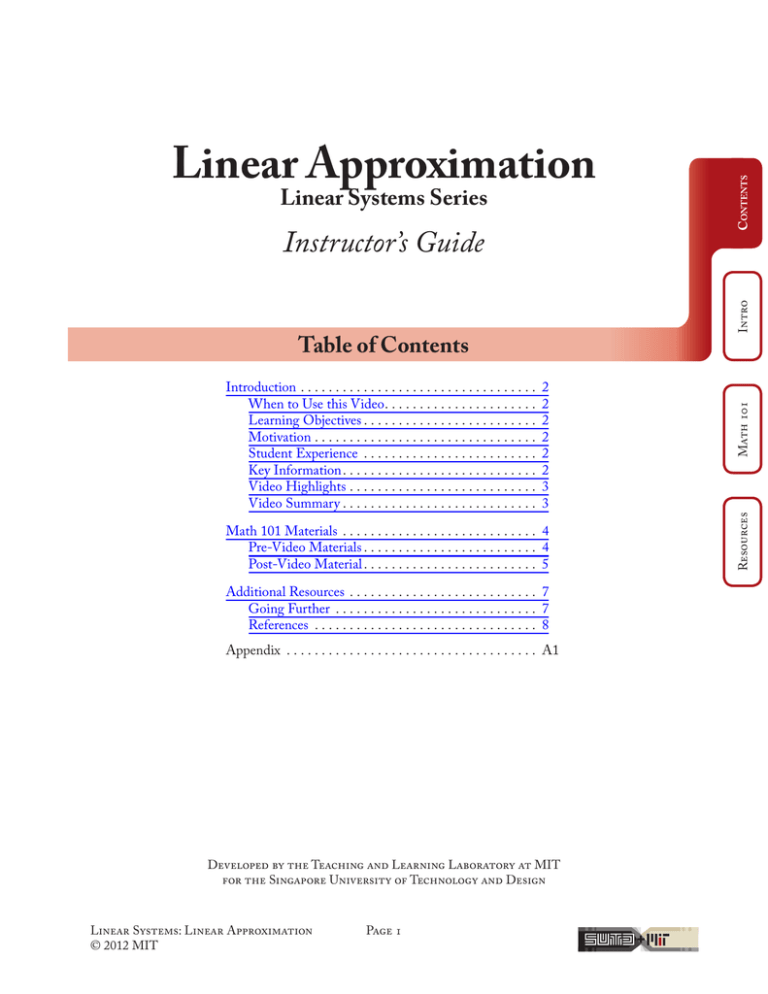
Contents CONTENTS Linear Approximation Linear Systems Series Intro Instructor’s Guide Table of Contents Math 101 2 2 2 2 2 2 3 3 Resources Introduction . . . . . . . . . . . . . . . . . . . . . . . . . . . . . . . . . . When to Use this Video . . . . . . . . . . . . . . . . . . . . . . Learning Objectives . . . . . . . . . . . . . . . . . . . . . . . . . Motivation . . . . . . . . . . . . . . . . . . . . . . . . . . . . . . . . Student Experience . . . . . . . . . . . . . . . . . . . . . . . . . Key Information . . . . . . . . . . . . . . . . . . . . . . . . . . . . Video Highlights . . . . . . . . . . . . . . . . . . . . . . . . . . . Video Summary . . . . . . . . . . . . . . . . . . . . . . . . . . . . Math 101 Materials . . . . . . . . . . . . . . . . . . . . . . . . . . . . 4 Pre-Video Materials . . . . . . . . . . . . . . . . . . . . . . . . . 4 Post-Video Material . . . . . . . . . . . . . . . . . . . . . . . . . 5 Additional Resources . . . . . . . . . . . . . . . . . . . . . . . . . . . 7 Going Further . . . . . . . . . . . . . . . . . . . . . . . . . . . . . 7 References . . . . . . . . . . . . . . . . . . . . . . . . . . . . . . . . 8 Appendix . . . . . . . . . . . . . . . . . . . . . . . . . . . . . . . . . . . . A1 Developed by the Teaching and Learning Laboratory at MIT for the Singapore University of Technology and Design Linear Systems: Linear Approximation © 2012 MIT Page 1 + Introduction Prior knowledge: the definition of the derivative, and the equation for a line through a point with a given slope Duration: 14:31 Narrator: Prof. Ben Brubaker Materials Needed: R5*,5(5*(#& R5&/&.),5),5)'*/., Intro INTRO Learning Objectives After watching this video students will be able to: R5 R5 R5 Recognize the linear approximation of a function as the tangent line to the function. Apply linear approximations to solve a simple differential equation. Explain the limitations of linear approximations mathematically and graphically. Motivation R5 There are student misconceptions that the tangent line of a function can only intersect the function at one point, as the tangent line to a circle. This is addressed in the video with an example function whose tangent line intersects it at more than one point. R5 Because many calculus problems are analytically solvable, linear approximations may seem unnecessary. This video provides scaffolding for using linear approximations to simplify differential equations. R5 A key element to keep in mind for students is that a linear approximation is only valid near the point where the approximation was made. This video ties the understanding of the range of acceptability to the definition of the derivative. Student Experience It is highly recommended that the video is paused when prompted so that students are able to attempt the activities on their own and then check their solutions against the video. During the video, students will: R5 Find the equation to the tangent line. R5 Posit why the tangent line is not a good approximation at any intersection point, but only tangent intersections. R5 Compute the error between the exact and approximated solutions to a reaction rate problem from chemistry. Linear Systems: Linear Approximation © 2012 MIT Page 2 Math 101 R5 In Math 101, before Unit 2: Applications of the Derivative, Lecture 6: Linear and Quadratic Approximations, in class or at home Resources R5 Key Information Contents When to Use this Video Video Highlights Chapter 1: Linear approximations defined 3:18 Zoom into function animation 6:37 Chapter 2: Example 7:55 Activity 11:11 Activity 12:11 Activity 12:53 Review Video Summary Prof. Ben Brubaker defines and explores the properties of the linear approximation of a function at a point. The linear approximation is then applied to solve a simple differential equation encountered in chemical kinetics. Linear Systems: Linear Approximation © 2012 MIT Page 3 Intro INTRO 1:38 Comments The prerequisite knowledge required for the video and the video learning objectives are detailed here. The linear approximation is defined as the tangent line. The relationship between tangent line approximations and differentiability is explored. Depicts the tangent line as a close approximation to the function when zoomed in sufficiently. An example scenario involving reaction rates in chemistry is worked through in detail. The concentration is found by making a linear approximation to the differential equation describing the reaction rate. Afterwards, the approximate solution is compared to the exact solution, and the error is explored. Find approximate concentration by applying linear approximation to simple first order differential equation. Determine whether linear approximation is an over-estimate, under-estimate, or equal to exact function. Find acceptable time range by analyzing when the error function is smaller than 5%. A review of video concepts is followed by a preview of how linear approximations are used to solve differential equations, and how Taylor’s Remainder Theorem can be useful in identifying the error bound of such an approximation. Math 101 Feature Introduction Resources Time 1:11 Contents This table outlines a collection of activities and important ideas from the video. Math 101 Materials When appropriate, this guide is accompanied by additional materials to aid in the delivery of some of the following activities and discussions. 1. Function (Appendix A1) Consider the function pictured in the graph below. At which points is the function NOT differentiable? (a) x = -10 (b) x = -5 (c) x = 0 (d) x = 5 (e) x = 10 The answer to this question includes all points where the function is not locally a line, so the correct answers are (b), (c), and (d). If students do not agree, have them explain their answers to other students until consensus has been reached. Linear Systems: Linear Approximation © 2012 MIT Page 4 Resources Math MATH 101 Because you may only take a linear approximation of a function at points where the function is differentiable, the following question is a concept check regarding differentiability. Intro Contents Pre-Video Materials 2. Begin a discussion about what it means for a function to be linear. Start with the following problem. (a) The equation for a line. (b) A function that is everywhere differentiable. (c) A function that is everywhere continuous. (d) A discontinuous function whose derivative is constant. Contents Choose all of the following that describe a linear function. Math MATH 101 The best answers here are (a) and (e). It is important for students to connect the concept of linearity to the familiar properties of the line. This idea can be explored further through class discussion. Ask students to provide counterexamples, finding functions that satisfy (b), (c), and (d), but are not linear. (Note that (d) is fairly tricky, and one example is the Cantor function.) Post-Video Material Intro (e) A differentiable function whose derivative is constant. 1. Function Approximations (Appendix A2) Resources At which points can the function pictured be linearly approximated? (a) x = -10 (b) x = -5 (c) x = 0 (d) x = 5 (e) x = 10 Note that this is the inverse of problem 1 in the Pre-Video Materials. Students should recognize that a linear approximation exists precisely at points where the function is differentiable, so the correct answers are (a) and (e). Linear Systems: Linear Approximation © 2012 MIT Page 5 2. In physics, it is common to make a small angle argument, which says that for angles V measured in radians sin(V) is approximately equal to V (b) Find a linear approximation for cos(V) when V"0. (c) Is this formula true if Vis measured in degrees rather than radians? Contents (a) Show that you can obtain this result by taking a linear approximation of sin(V) near V"0. 3. Approximate the value of the square root of 902. What is the error? Intro First have students break into small groups of 2 or 3 students and determine what should be true, and how to construct such an approximation. Once consensus has been reached among the small groups, after 10 or 15 minutes, open the discussion up to the whole group. They should arrive at the notion that the value of the polynomial should agree with the value of the function at the point 0. In addition, the first derivative of the polynomial should agree with the first derivative of the function at the point 0. Additionally, the second derivative of the polynomial should agree the with second derivative of the function at the point 0. In particular, students should become aware that a function will only have a quadratic approximation at points where it is twice differentiable. Linear Systems: Linear Approximation © 2012 MIT Page 6 Math MATH 101 4. Invite students to discuss how they would construct a quadratic polynomial approximation of a function at a point x = 0. Resources Additional Resources Taylor Series: Linear and quadratic approximations provide scaffolding for the eventual understanding of the Taylor series of a function. After working through linear approximations in detail, you may want to pose to students the problem of approximating a function at a point with a polynomial whose value, first derivative, and second derivative agree with the value, first derivative, and second derivative of the function at the point. Contents Going Further Ordinary Differential Equations: In ordinary differential equations, students will encounter differential equations that are not analytically solvable. An approach to gaining intuition, or arriving at an analytic solution necessarily involves making an approximation, often linear or quadratic, near some region of interest. Students will also encounter partial differential equations that are unstable, but are linearized near critical points. These methods for solving such differential equations are basic and fundamental to the physical sciences. Students having difficulty with such methods might want to return to these materials to refresh their memories. Multivariable Calculus: The linear approximation for a single variable function may be helpful for students beginning to define linear approximations to functions of more than one variable in a multivariable calculus course. Linear Systems: Linear Approximation © 2012 MIT Page 7 Math 101 Small Angle Approximation: Approximations occur frequently within physics. Every small angle argument can be thought of as a linear approximation. Highlighting this fact can make the approximation seem less opaque to beginning students who do not understand why they are making the approximation, and where it is valid. Resources RESOURCES Taylor polynomials are fundamental to a study of numerical methods. Once a student is aware that a function is better and better approximated by Taylor polynomials with more terms, it may then become counter intuitive that a method based on a linear approximation would converge more quickly than a method based on a quadratic approximation, or Taylor polynomial of degree two. Intro An understanding of Taylor series allows a student to gain a stronger hold on understanding where a Taylor polynomial is an acceptable approximation through the use of the Taylor Remainder theorem. References Schoenfeld, A. H. (1989). The Curious Fate of an Applied Problem. The College Mathematics Journal, 20(2), 115–123. The following reference regarding chemical kinetics is where the information for the example in this video was verified. R5 Zumdahl, S. S. (1989). Chemical Kinetics. Quesne, M. L. (Ed.) Chemistry. (2nd ed., pp.513–538). Lexington, MA: D. C. Heath and Company. These video references discuss linear approximations, and are available on MIT Open CourseWare. R5 R5 R5 Intro R5 Kajander, A. & Lovric, M. (2009). Mathematics textbooks and their potential role in supporting misconceptions. International Journal of Mathematical Education in Science and Technology, 40(2), 173–181. Strang, G., Linear Approximation/Newton’s Method, Highlights of Calculus. (Massachusetts Institute of Technology: MIT OpenCouseWare), http://ocw.mit.edu (Accessed Mar. 2, 2012). License: Creative Commons BY-NC-SA Jerison, D., 18.01 Single Variable Calculus, Fall 2007. (Massachusetts Institute of Technology: MIT OpenCouseWare), http://ocw.mit.edu (Accessed Mar. 2, 2012). License: Creative Commons BY-NC-SA -Lecture 9: Linear and Quadratic Approximations Auroux, D., 18.02 Multivariable Calculus, Fall 2007. (Massachusetts Institute of Technology: MIT OpenCouseWare), http://ocw.mit.edu (Accessed Mar. 2, 2012). License: Creative Commons BY-NC-SA -Lecture 8: Level curves; partial derivatives; tangent plane approximation. Linear Systems: Linear Approximation © 2012 MIT Page 8 Math 101 R5 Gordon, S. P. (1991). Introducing Taylor polynomial approximations in introductory calculus. PRIMUS, 1(3), 305–313. Resources RESOURCES R5 Contents A list of articles highlighting misconceptions about linear approximations, a collection of in class activities, and references for going further are below. Function Page A1 !"# $%&%'() % !*# $%&%'+ % !,# $%&%)% !-# $&+% !.# $&()% % % % % % % % % %% % %%% /0112.%"33%415672%80.9.%70.%:;6,<16%52%=>?% -5@.9.6<"*3.A% Function Approximations Page A2 !"# $%&%'() % !*# $%&%'+ % !,# $%&%)% !-#$&+% !.# $&()% % % % % % % % % %% % %%% /0112.%"33%415672%80.9.%70.%:;6,<16%!45,7;9.-%"*1B.#% ,"6%*.%356."93C%"4491$5D"7.-E% MIT OpenCourseWare http://ocw.mit.edu RES.TLL.004 STEM Concept Videos Fall 2013 For information about citing these materials or our Terms of Use, visit: http://ocw.mit.edu/terms.
